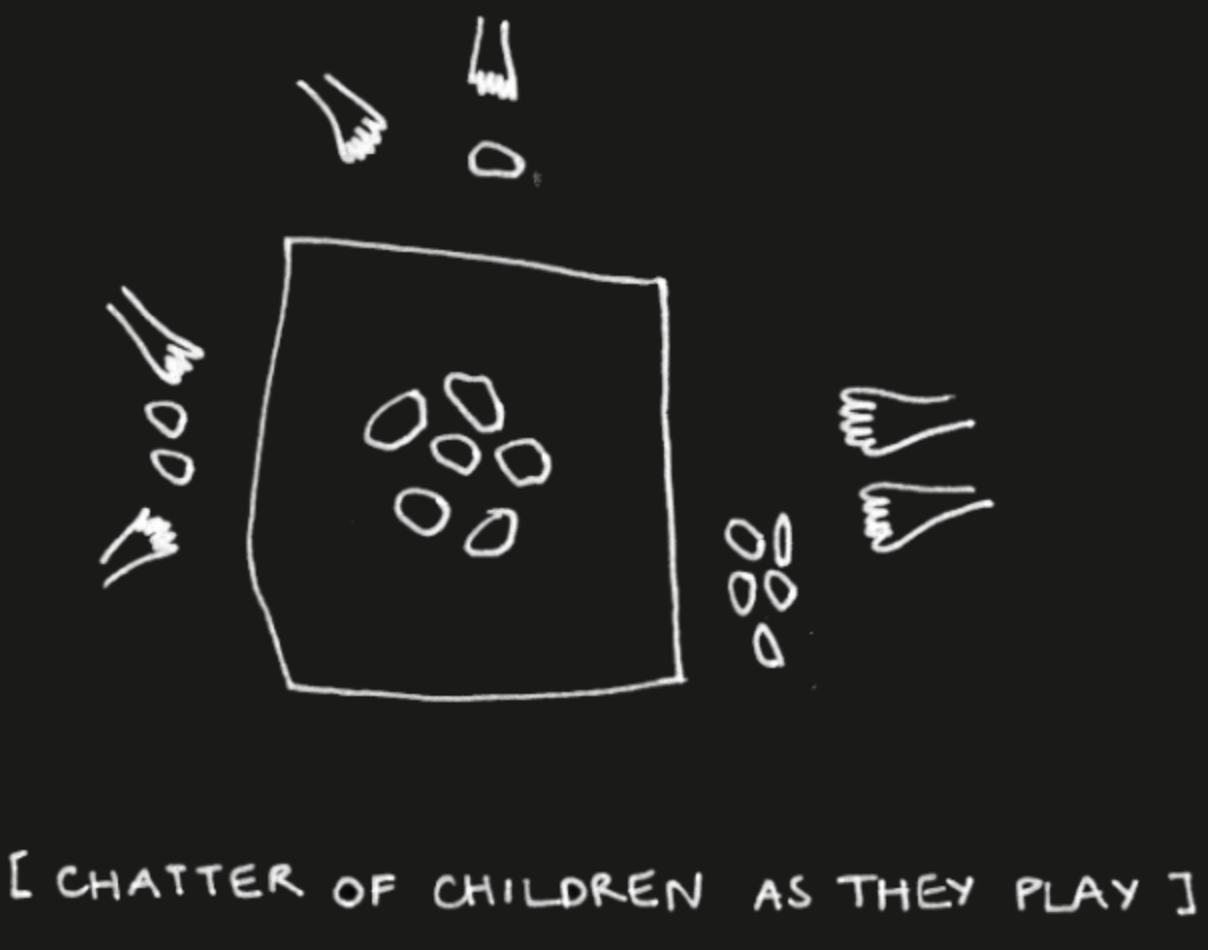On listening beyond the endings in ‘And still, it remains’
By Niki Kohandel
Niki Kohandel is an artist, filmmaker and facilitator. Her practice sits in the space between recording and rewriting a story. She works in collaboration with family members, friends and young people, playing with languages, analogue film, childhood memories and colours. She is currently a Cubitt artist in residence at the Arts and Media School Islington, where she shares her story-telling practice with students through workshops, talks and paper boat making.
‘The way the bomb exploded
they thought that maybe it was the end of the world.’
The elderly man from the Escamaran tribe who is speaking might or might not be off-screen. An inhabitant of Mertoutek, an oasis in the Algerian Sahara, he recounts the aftermath of French nuclear tests carried between 1961 and 1966, a set of experiments which produced what we could call an ongoing apocalypse. His story joins those of other inhabitants, their narration describing a continued resistance against the end of their world.
Arwa Aburawa and Turab Shah’s work is named as an affirmation of this resistance: And still, it remains. In the film, it is less image than sound which prevails and carries that memory. Voices, both human and non-human, tell of the struggles faced since the beginning of the Jerboa operations, which continued for another four years after Independence. The film refuses to operate on voyeuristic or sensationalistic premises, turning instead our attention to the act of listening and to more-than-human transmissions. It reaffirms a radical understanding of worlds perpetually ending and surviving, as a result and in spite of colonialism’s necrophilic endeavours.
‘All they wanted from the Touareg was to photograph them’
As it tunes in to a chorus of voices, And still, it remains counters the colonial narrative that envisions the desert as a void, uninhabited space, a blank canvas awaiting to be painted by the European traveller’s daydreaming. Nomads were and are still regarded by the colonisers as either ‘insects’ or objects for the orientalising camera lens, another person from Mertoutek denounces. The accusation is not only directed at the unspeakable crimes of the French state, but also at the complicity of the Algerian government that enabled the Sahara to remain a target post-1962. The film grapples with representing the catastrophe without the images usually associated with it. Death, illness and radiations are present yet unseen, bypassing the injunction to display disaster. From afar, we observe people tending to their land and going about their daily lives as they come in and out of the frame. In a place where cameras were repeatedly used as weapons, it is here used to enforce respect, acting as a barrier. The desert is no place for western fantasies, this environmental tragedy is no spectacle for the well-meaning movie-goers and documentary devotees.
[An unsettled tone haunts the sound of the wind]
Whilst the camera deliberately maintains distance, rejecting the primacy of sight, Aburawa and Shah invite us to come closer with our hearing. The film’s sound score by Sami El-Enany relays echoes of persisting life, underlining the status of the desert’s elements as story-tellers in their own right. We listen to the man who saw the nuclear explosion with his own eyes, just as we listen to the wind’s trajectories (1), the movements of sand (2), the cries of crops in contaminated soil (3), to the sounds of unwavering, quiet beginnings (4). A poetic thread directly weaved into the fabric of the film, the captions also serve in relaying these calls. More importantly, they summon us to attend to what lies below the surface of the screen. Operating not unlike a music sheet, they translate for us the sounding patterns of the wind across the Hoggar mountains. And we can hear that it too, is seeking a justice that could never repair or untangle from the radiations.
‘There is a divine power that tells us
justice will come, even after all these years.’
From another inhabitant, we learn that the snake which has been attacked does not forget nor have respite until it has found its abuser. The metaphor is potent: the wind of the Sahara, like the snake who strikes its aggressor, blew some of the radioactive dust back to France. The transmission of memory is presented as a tool, intrinsically tied to resistance. Whilst the loss did not only occur after the explosion but is rather ongoing, so is the will to remain. It is only by remaining on these lands that its people can remember what was done to it: forgetfulness is thought of as the ultimate acknowledgment of defeat. But the question of justice is another one: whilst this scarred environment is able to a certain extent to retaliate, the very nature of these radiations means they surpass any human scales of time. There is no resolution to be offered, no human word to apologise, no action capable of remediation. In this context, meaning can only derive from orienting our understanding of justice in a different direction, placing it in the hands of the divine.
[An amplified voice fills the landscape]
As it moves away from direct representations of the nuclear disaster and radioactive fallout in the Algerian desert, And still, it remains also acts as a timely reminder that the apocalypse was never a defined moment in time, but rather an ongoing violence serving the colonial projects of imperial entities. Refusing to perpetuate an intrusive or subjugating gaze that marks the visual medium’s legacy, the film presents listening as a strategy for effecting solidarity. Whilst questioning our conception of resistance and justice, it urges us to attune to the various life forms which remain and sound beyond the endings.
Illustrations from captions in And still, it remains
[Leaves brush against the wind]
[Sand shifts tenderly under fingers]
‘[Chatter of children as they play]’
‘[Roots of the spring onions tear as they are pulled out]’
‘[Birdsong]’






